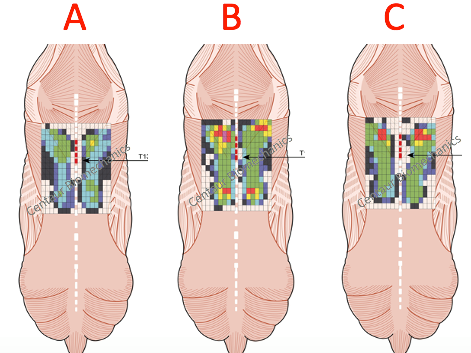
Saddle fitting is complex: individuals are required to fit a fairly rigid structure to a dynamic platform which has to conform to the shape of both the horse and rider whilst distributing forces. The complexities are further compounded with alterations in body shape (horse) occurring as a result of seasonal changes, exercise, body weight, travelling etc. To highlight this further, we have shown changes in back shape throughout an eight-hour period (1) and others have shown changes after 30-minutes of exercise when ridden in a correctly fitted saddle (2).
We and others have extensively investigated the effect that saddle fit and design can have on saddle pressures, equine locomotion, back health and function. In respect of saddle fit, a horse which is ridden in a saddle which is “out of balance” can create areas of high pressure causing the horse to adopt a locomotor strategy to compensate. This compensation strategy can result in asymmetries, and asymmetries can lead to asymmetric forces and sadly this can result in over/under load of structures. The importance of saddle fit should not be underestimated for all horses, in all sports and riding activities. The horse can feel a fly…in the case of incorrect saddle fit, the horse develops a locomotor strategy to alleviate any discomfort caused.
(Images A: Correct fit - uniformed pressure; B= saddle which is too narrow - 4 points of pressure; C= saddle which is too wide - localised pressures at the front)
Given the complexities and factors which affect saddle fit and the direct link with saddle fit, back health and locomotion, it seems logical and crucial that a qualified individual should be responsible for saddle fit. With advances in research and methods, saddle fitting has evolved for the good of the horse. In 2016 we ran a poll and just over half of the responses were aware if their saddle fitter was qualified and just over half thought that it was important that their saddle fitter was qualified. Comparing the poll to the one we ran recently (2021) there appears to be a shift with the majority of responders recognising that their saddle fitter is qualified and majority recognising the importance of using a qualified saddle fitter.
This is hugely positive. Like all sectors within the industry there are qualifications which can be achieved in a fairly short time (i.e. weekend courses) to qualifications which follow an in-depth process (i.e. Society of Master Saddlers (SMS) +3 years). Whilst the differences are clear, as a due diligence mechanism it is important for individuals to be aware of differences in qualifications and the training process/duration etc. Another consideration is the continual development of the qualification, as highlighted at the beginning of this blog, through evidence we are understanding the complexities and challenges of saddle fit therefore, it seems essential that practising saddle fitters are up to date with advances in research and methods in order to optimise saddle fit for the good of the horse.
I hope the above is of interest and helpful as mentioned previously, we must not underestimate the effect that the saddle and saddle fit can have on equine health and performance.
Long gone are the days where saddles arrive through the post in a box or saddles which are fitted without any ridden observations – or at least I hope!
Please SHARE to raise awareness on the complexities of saddle fit.
Kind Regards
Dr. Russell MacKechnie-Guire
www.centaurbiomechanics.co.uk
#equineresearch #biomechanics #centaurbiomechanics #veterinarymedicine #equinephysiotherapy #equinetherapist #onlinecourses #onlineseminar
1) R. MacKechnie-Guire, M. Fisher, D. Fisher, T. Pfau, V. Fairfax,, 2020. Variations in epaxial musculature dimensions and horse height over a period of eight hours. BEVA 2020 Congress. https://doi.org/10.1111/evj.08_13365,https://beva.onlinelibrary.wiley.com/.../10.../evj.08_13365
2) Greve L, Murray R, Dyson S. Subjective analysis of exercise-induced changes in back dimensions of the horse: The influence of saddle-fit, rider skill and work quality. Vet J. 2015;206(1):39-46.